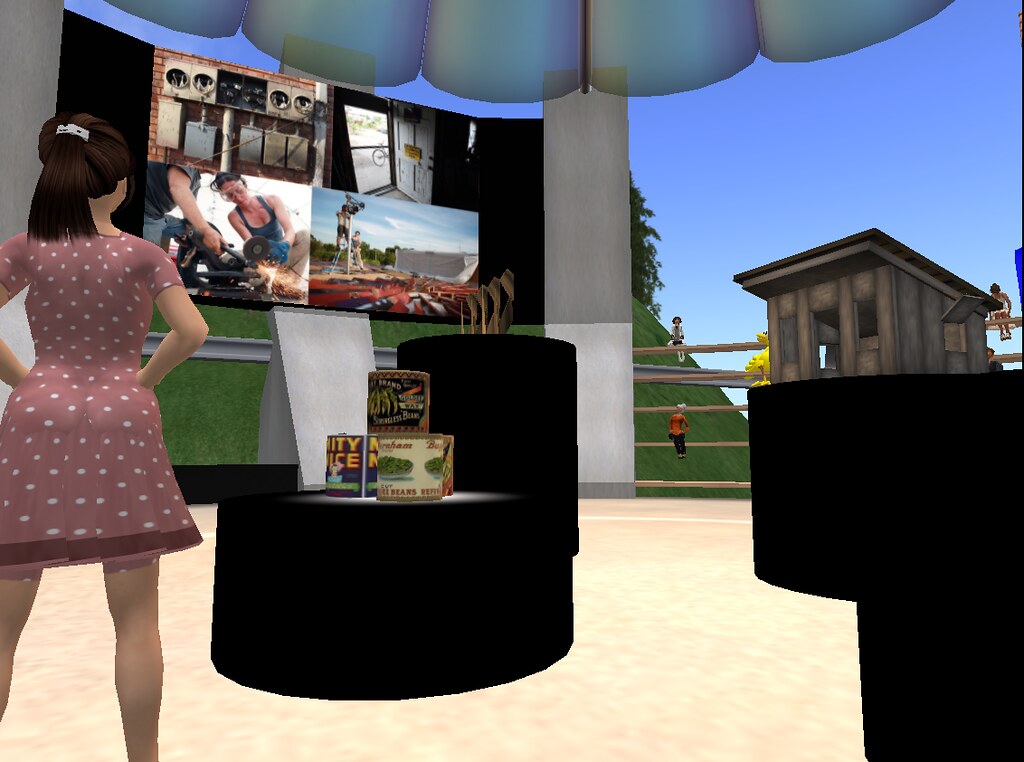I almost stopped writing, as this image just makes me want to be in a world where presentations are this exciting.
Frankly, now coming up on 18 years in the ed tech game, the differences from the experience of my very first educational conference to my most recent is perhaps better quality projectors. We still stand up and point at slides of Japan and work our audience up into a lather, right?
While I’ve been in agreement with Martin long before he even posted about being done with conferencing — I too sport a GUILTY sign for really not doing a whole lot about this, besides the yearly whinge blog post on this topic.
There definitely has to be a better model than the One with The Slides in front of the Ones in the Seats for 45 minute segments.
At the same time, we know the are people who excel at getting up and doing this. So its not all the problem with the format. And it certainly is not the technology or platform (when we move to talking about online presentations).
Instead of better slides and videos and twitter back channels, might we need more of this?
I’ve been reflecting on the presentations, both in person and online, from the past few months, and trying to zero in one a few things. First of all, I don;t know where The memo came from, but speaking in a monotone (or worse) reading from a sheet of paper, is a signal of a snoozer. Even if the ideas are good. Where is the truth that speaking in emotionless flat voices is a sign if superior intellect?
I’m thinking of one person who serves as a star model for presenting ideas– Bryan Alexander. For those that know him or have hear him, you know he is a sheer force of a personality, and flows with energy. You will never catch him monotoning it. But let’s take a closer look. at three bits of Bryan-ism.
In person, speaking, he exudes dynamism- he paces the room, he waves his arms, he draws you in with a depth of knowledge and history, he pushes 60 slides per minute of mostly visuals. He’s also one who always give you a way yo access all his resources, be it on wiki, slideshare, etc. But what he does mostly is share his ideas in a very Bryan and human fashion.
But he took that to a new level at the May 2010 Northern Voice conference, where his keynote took place in a very lovely and daylight filled atrium at UBC- and slides were not possible. As he described it, he was “powerpointless”. Yet he carried his message out in the oldest form, the spoken word. Slides were not even needed. The sheer force of personality.
I don’t think I’ve ever even tried presenting that naked of media. I think we need to do more of that.
The last bit is how Bryan brings his message in an online conference. Our 2010 NMC Symposium for the Future was held in Second Life, and environment that Bryan does not hold back his criticism of. We had some major challenges with the client software and his audio, but he thankfully persisted.
The platform only conveys his ideas, it becomes a secondary factor- he really transcends the platform and technology with the richness of his message, and mostly, again his human side oozes from even an avatar. You can hear it in the audio archive.
So you might say, sure that’s Bryan, he has that cool beard and all the occult/game interests.
Take a listen to a different presenter from that same NMC online conference, my friend and colleague Sian Proctor, who I arm twisted to share her experiences and perspectives on the future, from her being a participant in the Discovery channel’s reality show, The Colony. See the videos, slides, and hear the audio from her session on Post Apocalyptic Technology ““ What does that really mean?
What she did so well was to speak in her natural voice, and show again, genuine excitement and passion about her topic.
Or catch the archive of a recent Connect@NMC session with Lynda Weinmanwhere she told, again in a even, but animated and human voice, her own story and ideas on changing education. Humanness radiated the session.
I am really thinking many of us (me first) need more experience at improv than at making slides.
Before moving back to face to face conferences, I will share you one thing that works horribly in online conferences – playing videos longer than a short clip. We tend to hold the illusion that these synchronous environments can broadcast video like a TV signal, that people will see it smoothly from start to finish as we do on our desktops. From where I live with marginal broadband at home, I can say for sure that one’s experience of video varies wildly with variance of network connectivity. Invariably, some people will see video smoothly from start to end; others will have longer play times with more buffering, and others will see almos nothing.
If a video is that crucial, make sure you send the URL via chat and make it available later, but honestly, unless you can be sure every audience member has the same quality connectivity, playing a video, specially something more than a few (I’d keep it to 1-2) minutes, is a killer.
But really, the format is stale as that mystery vegetable in the back of my fridge. There has to be different formulas that a steady pummeling of 45 minute mono-sessions. Don’t get me wrong, the organization and offering a the free Global Online Conference is on a scale I’ve never seen or imagined, something like 400 sessions, 60+ keynotes. it’s a huge world-wide opportunity– yet I’m getting worn out just thinking about looking at the program. Of course, with an event like this, you can pick and choose the 3 sessions you want, and get a ton out of it.
Yet it is the form again that has not changed. One or two, maybe three people talking over slides to an audience for 45 or 50 minutes. Repeat 400 times. It will take 14 days of full time watching to see all the archives (make sure someone brings you food and water).
My recent experience at the TEDxPHX was a tiny bit of a different and fresher flavor on the format, for at least a shorter form, and mixing up live sessions, with music performances and shared videos (in this space, videos worked great!). Yet… there really was no role or thing for us as an audience to do except to be an audience. They presented, we watched. Not much interchange.
This is all background into some thinking I am trying to do for our Spring NMC Online conference planning. The cool thing about our Virtual Symposia is that we don’t just base it on what we know works as a technical platform, we flip it over, turn it inside out, and re-invent it every few years. That was the impetus that led us into exploring 3D virtual spaces for these conferences in 2007-2010.
it’s time again to mix it up. For me, despite the barrier of entry, the limits on numbers of participants, what was most key about a Second Life virtual conference space was that it persisted when there were no sessions were going on. It was a place, and there were more ways to express oneself than typing in a chat box. When you go to a web based conference (e.g. Elluminate, Connect, WebEx, et al)- when the session ends, pretty much the conference space/place evaporates. Sure people can bounce messages in a discussion forum or twitter streams, but it’s like being at a conference center that disappears when the speaker stops talking.
Synchronous conference software have not evolved all that much in function from the ones I first saw in the early part of this decade. Share slides/media on a screen. Hear live audio or a tiny video of a person in a box, communicate in chat. The differences in the platforms are really more cosmetic than functional.
So because I think it is the force of the personalities that matter, more than the technical platform, it is less of a matter of looking for a new technology, and more a goal of re-inventing the format and activities. Busting up the cookie cutter agenda of keynote breakout breakout breakout breakout. Fold in more smaller activities where more people contribute/participate. Find ways for the space to persist. Break out the session notion of Me on the Stage Telling You Something and move parts of it more to people actually doing something, not just listening to someone talk about something they did.
These are just vague ideas floating around my cortex, but we are going to make our next online conference rather different, and I most want to make the audience experience different.
Featured Image:









Heck, even just simple things like “Fireside Chat”/interview formats is refreshing when compared to The Drone (of which, mea culpa as much as the next guy). Why is this so damn hard?
The post presentation chat is definitely on my list — “fireside chat” was something I liked from K-12 Online conference, which also twists the format nicely as the presentation materials are all done in advance as videos or media sets.
The past NMC symposium on creativity and the first NMC one based in a virtual world really went a long way to doing something different from ‘talk over slides’. This was in large part ‘coz the NMC staff challenged potential presenters to not do this but to do something that exploited the platform more.
That challenge to “do differently” is needed all over again but there are some other issues too.
Another issue/downside is attendance of live virtual events for those far away from North/South American timezones. Do we need to push people to have region clusters and time slots? (as was done way back in 90’s with global learn day on the internet and more recently with the SLactions event last year and this year). Can we push the NMC members in EU/Africa to cluster and generate another ‘slot’ and AU/NZ/Asia for yet another?
Those early Sl symposia were electric, a lot of newness. The 2006 Impact of Digital Media Symposium especially because it was somewhat ad-hoc (conference materials were wiki based), stretched loosely over a longer period when people could come and go). Our later ones went to a more regimented schedule.
We hear ya on the international time zones diffs; maybe something to work on with activities built around the sessions rather than the sessions themselves.
Some random thoughts.
1. A good lecture can be gold. Whether it’s sans slides or full of great visuals, a great lecture is still a worthy instructional strategy and even entertaining.
2. After attending my first TEDx event I was thinking about a couple of presenters that didn’t use slides and kept thinking how even a few visuals would have made their stories better. Not sure if that’s simply a personal bias or a fact. Is this sort of like thinking about going acoustic/unplugged as an alternative or are we indeed better with the full band?
3. I’m also okay with having to sit and listen without interaction….at least for a while. What I liked about the TEDx format is that they encouraged and facilitated conversation after the sessions. And it worked. Backchannels are fine and purposeful. Delayed backchannels can be effective too.
4. Organizers who have some sense of who’s got game and who doesn’t is key. Again, at the TEDx event you had 18 minute talks mixed with 5 minute talks. The 5 minute talks, even if they weren’t all that compelling were pretty bearable. Most of the 18 minute talks were more experienced folks who kept the audience engaged. Why are keynotes always an hour? If we want to play with format a bit, we should be playing more with time rather than style.
I guess what I’m saying is that I’m not sure we need to explore new formats. Fine if we do and you are one person that I look to for inspiration to adding a new twist to the story and presentation to keep folks engaged. Yet we both know, as you indicate with the title of your post, it’s not the whole enchilada.
All good points you Share(ski)-ed. I got a similar reaction at TEDx- it was the shorter time frame, the mix of topics, and the mix of formats/time slots that made it fresher. We had bursts of sessions but then good solid 1 hour breaks to mingle and talk.
I may be thinking not as much of blowing up the format, just mixing it up more. Thanks
I think it’s ok for some presentations – but the point is most of us aren’t good public speakers, and no amount of training will make us so, we not ‘performers’. So in some ways the technology doesn’t matter. But I think the format does – ironically if you are not a good speaker then speaking to a paper is not a very good format. So, as Scott suggests I think conferences can do much more to make people think about different formats or give them different ones. If you ask for papers for example, then that leads to the types of presentations we get. If you ask for ‘discussion groups’ or something you’d get a different type of interaction.
I also think we’ve become lazy – we put together a presentation at the last minute because we know how to do that. It calls to mind the Mark Twain quote “I didn’t have time to write a short letter, so I’ve written a long one instead”, it’s more like “Sorry I gave a boring presentation, I didn’t have time to do an interesting one”.
So there is much that conferences can do here, but as I suggested I’m worried that the finances around them force them into a more conservative approach.
I agree that some large-ish proportion of what makes a presentation work or not is the speaker. I’ve seen great presentations with powerpoint/keynote/presi/wikified-slides/flickr images/etc/etc and great presentations without. I’ve seen great panels with 2-5 people and horrible panels. I’ve seen horrid presentations done sans media and fantastic presentations integrating the backchannel into the converation, etc etc etc. I’ve been part of good and bad “conversations” that took the place of presentations. Some of the WORST sessions I’ve endured have been set up as what I think Leslie is referring to as “fireside chats.” But some good ones too.
The only common denominator seems to be the person/people taking part.
Having managed to stick fairly well to my own “I’m done with conference presentations” commitment, I realize that this has much more to do with my own failings as a presenter/speaker/communicator than anything else.
So what can be done? I agree that the fundamental nature and model in which the “presentations” are situated needs to change… and that’s a REALLY difficult thing to do (I say this having just endured a year of trying– and failing– to bring something different to a conference) because of all the stifling forces at work, from the overcommittments on the part of the organizers to the lack of will on the part of the administration to the lack of commitment on the part of the presenters. To change this model means not just equipping a venue differently, but getting people to plan and execute differently well before the conference. How can we *make* that happen? I sure didn’t have much luck at this most recent event or any other.
I have tried to innovate on my own in various ways, and while you seem a bit (and perhaps rightfully) dismissive of such things as bringing in the back channel, just-in-time crowd sourcing, etc., in the end that’s the only thing I’ve been able to do because it always ends up just being me trying to do something different within a frame that doesn’t have much room or tolerance for that difference.
And I think I’m a tiny smidgen above average… but there has to be room for those of us who aren’t Bryan Alexanders or Gardner Campbells… doesn’t there?
What has been interesting to me over time and over conferences is how often the good presenter (and even the bad at times) is surrounded by people after the presentation. People who are desperate to carry on/start conversation- even when time allotted for questions was given and not used. I think there’s something to that which might be addressed structurally.
I think the good presenters have some mix of their own personality/style/dynamics, solid content and an understanding of their audience as well as the ability to read it as they progress. So P*C^A = good presentation. I see that mix of art and science as a lot like teaching in that there are some core things that will make you better but you have to find a style that fits you and then adapt to your audience and content in a fluid way.
PS – You and I must share similar tastes, I’ve used the 1st and last picture in your post in a few presentations. Not huge odds given the CC limitation but still pretty decent.